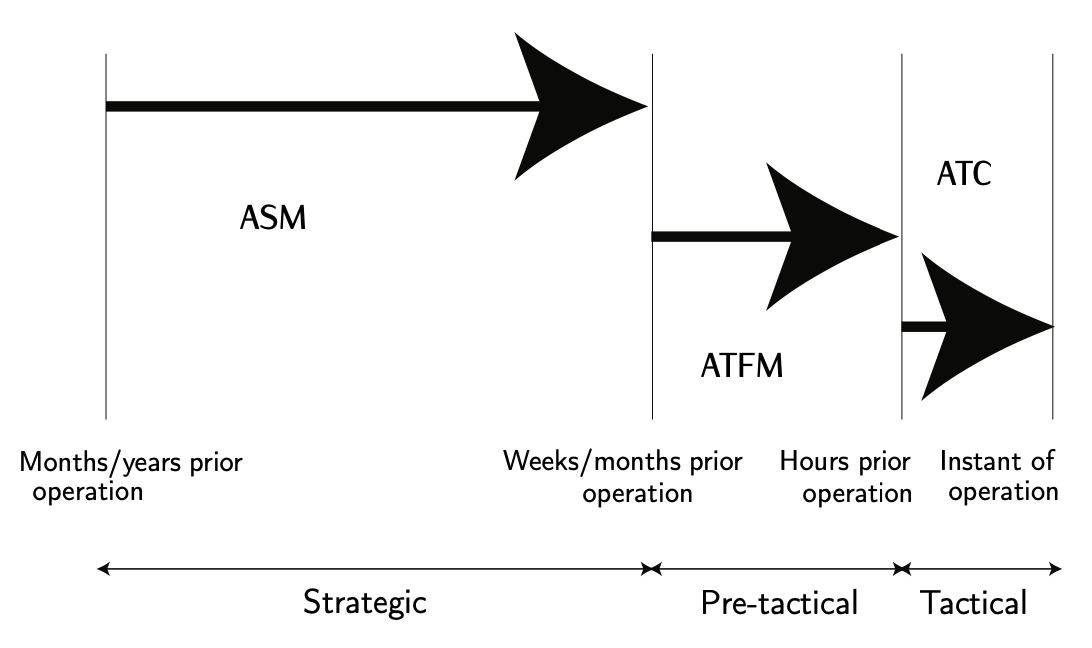10.2.3: Air Traffic Management (ATM) services
- Page ID
- 78377

Figure 10.6: ATM levels.
The Air Navigation Service Providers (ANSPs), i.e., AENA in Spain, FAA in the USA, Eurocontrol in central Europe, must have technical capabilities to develop and support a technical CNS infrastructure, but on the other hand, it is also needed a highly structured organization with high skilled people, forming the operational support needed to provide transit, communication, and surveillance services. This operational infrastructure is referred to as Air traffic Management (ATM).
ATM is about the process, procedures, and resources which come into play to make sure that aircraft are safely guided in the skies and on the ground. If we consider the time-horizon between the management activity and the aircraft operation, we can identify three levels of systems:
- AirSpace management (ASM). (Strategic level).
- Air Traffic Flow and capacity Management (ATFM). (Pre tactical level).
- Air Traffic Control (ATC).7 (Tactical level)
Airspace management (ASM)
The first layer of the ATM system, the so-called Airspace Management (ASM), is performed at strategic level before aircraft departure, within months/years look-ahead time. The ASM is an activity which includes airspace modeling and design. As aircraft fly in the sky, they follow pre-planned routes conformed by waypoints, airways, departure and arrival procedures, etc. The route followed by an aircraft is selected by the company before departure based on the airspace design previously made by the ASM. The ASM activity includes, among others, the definition of the network or routes (referred to as ATS routes), the organization of the airspace in regions and control sectors, the classification (determined airspace is only flyable by aircraft fulfilling determined conditions) and the delimitation (some regions of the airspace might be limited/restrung/prohibited for civil traffic) of the airspace. All this information is in turn published in the AIP. Section 10.3 will be devoted to airspace management and organization, and all these issues will be tackled in detail.
Air traffic flow and capacity management (ATFM)
The second layer of the ATM system is the so called Air Traffic Flow and Capacity Management (ATFM8). It is performed at pre-tactical level before aircraft departure, within weeks up to three hours look ahead time. The idea is the following: Once the flight plan has been determined by the company according to its individual preferences and fulfilling the ASM airspace design and organization, the next step is to match the flight plan with all flights to be operating at the same time windows in the same areas in order to check whether the available capacity is exceeded. This is an important step as only a certain number of flights can be safely handled at the same time by each air traffic controller in the designated volumes of airspace under his/her responsibility. All flight plans for flights into, out of, and around a region, e.g., Europe, must be submitted to an air traffic flow and capacity management unit (the Eurocontrol’s Central Flow Management Unit (CFMU) in Europe), where they are analyzed and processed. Matching the requested fights against available capacity is first done far in advance for planning purposes, then on the day before the flight, and finally, in real-time, on the day of the flight itself. If the available capacity is exceeded, the flight plans are modified, resulting in reroutings, ground delays, airborne delays, etc. Section 10.4 will be devoted to study the ATFM.
Air traffic control (ATC)
The third layer of the the ATM system is the so-called Air Traffic Control (ATC9). It is performed at tactical level, typically during the operation of the aircraft or instants before departure. The idea is the following: once the flight plan has been approved by ATFM, it has to be flown. Unfortunately, there are many elements that introduce uncertainty in the system (atmospheric conditions, measurement errors, piloting errors, modeling errors, etc.) and the flight intentions, i.e., the flight plan, is rarely fully fulfilled. Thus, there must be a unit to ensure that all flight evolve safely, detecting and avoiding any potential hazard, e.g., a potential conflict, adverse meteorological conditions, by modifying the routes. This task is fulfilled by ATC. ATC is executed over different volumes of airspace (route, approximation, surface) in different dependences (Area Control Centers (ACC) and Control Tower) by different types of controllers. Controllers use communication services to advise pilots. Also, pilots are aided by the FIS and ALS. All these systems together increase the situational awareness of the pilot to circumvent any potential danger. Section 10.5 will be devoted to study the ATS, in particular the ATC.
7. To be more precise, ATC belongs, together with the Flying Information Service (FIS) and the alert service (ALS), to the so-called Air Transit Services (ATS). Due to its importance, we restring ourselves to ATC.
8. The acronym ATFCM might be used as well. ATFM and ATFCM can be used interchangeably
9. As already mentioned before, to be more precise, the third layer is referred to as Air Transit Services (ATS), which is composed of the Flying Information Services (FIS), the Alert Services (ALS), and, fundamentally, the Air Traffic Control (ATC). Since ATC is by far the most important one, it has been typically used as the third layer by itself. We adopt the same criterion, but it is convenient not to forget the FIS and ALS.


